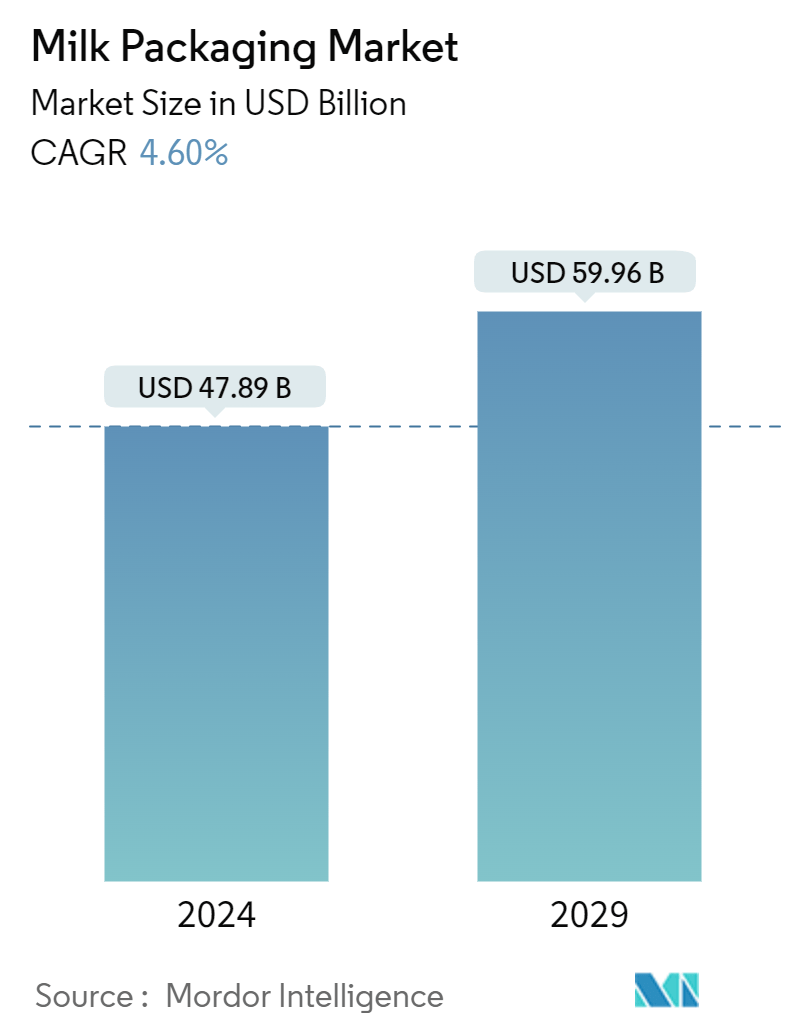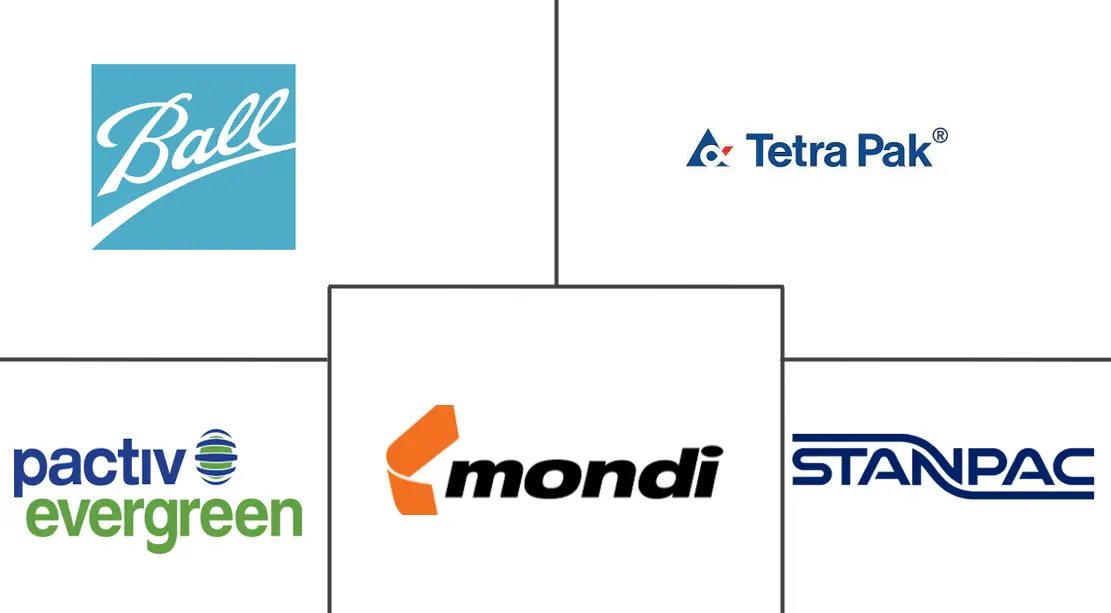Market Size of Milk Packaging Industry

| Study Period | 2019 - 2029 |
| Market Size (2024) | USD 47.89 Billion |
| Market Size (2029) | USD 59.96 Billion |
| CAGR (2024 - 2029) | 4.60 % |
| Fastest Growing Market | Asia Pacific |
| Largest Market | North America |
Major Players
*Disclaimer: Major Players sorted in no particular order |
Need a report that reflects how COVID-19 has impacted this market and its growth?
Milk Packaging Market Analysis
The Milk Packaging Market size is estimated at USD 47.89 billion in 2024, and is expected to reach USD 59.96 billion by 2029, growing at a CAGR of 4.60% during the forecast period (2024-2029).
The growing inclination toward eco-friendly packaging and increasing flavored milk consumption is expected to drive market growth.
- Milk is the most consumed dairy product in the world. The high content of moisture and minerals in milk makes it very challenging for vendors to store it for a long period. It is one of the major reasons for milk being traded as milk powder or processed milk. More than 70% of fresh milk packaging is contributed by HDPE bottles, leading to lesser demand for glass bottle packaging. The trend of on-the-go consumption, the convenience of the easy pour, appealing packaging quality, and health awareness reflected by the popularity of drinkable dairy-like, soy-based, and sour milk created a significant demand for milk packaging.
- According to FAO, global milk production is projected to grow by 177 million metric tons by 2025. Due to changing lifestyles and rapid urbanization, increasing consumer preference to gain proteins from dairy products rather than cereal sources. It is expected to drive the demand for products, like milk, over the forecast period. Such trends are further expected to influence the milk packaging market.
- Bio-based packages are more sustainable than standard milk cartons, reducing the manufacturer's reliance on fossil-based polyethylene plastic in the lining. Consumer interest in sustainability is increasing, with research indicating that people of all ages believe businesses should take responsibility for their environmental footprint.
- Moreover, cartons are being adopted as an ideal option for packaging milk for retail distribution. Companies are increasingly adopting aseptic cartons and pouches for milk packaging. Research shows that the organoleptic quality of aseptically processed UHT milk includes significant benefits in lactulose, lactoserum proteins, and vitamin content compared to retort processing.
- However, consumers and manufacturers are worried about the detrimental effects of plastics and other non-biodegradable packaging materials. As a result, companies are converting to biodegradable packaging that is good for the environment. Manufacturers employ green packaging techniques that emphasize using lighter materials and promote recycling. Environmental law is also projected to impede the growth of milk since greenhouse gas emissions from milk packaging represent a significant part of total emissions in some countries, and any changes to associated rules may influence milk production.
Milk Packaging Industry Segmentation
Milk packaging is important to protect, carry, market, and sustain its freshness and convenience. Various packaging types are used for milk packaging, such as bottles/containers, cans, cartons, and pouches/bags. The packaging trends vary concerning the country and region. There are several reasons to ensure the durable packaging of milk, like safety, information, ease of storage and handling, and avoiding distribution damages.
The milk packaging market is segmented by packaging type (cans, bottles/containers, cartons, pouches/bags, and other packaging types), material (plastic, paperboard, and other materials), and geography (North America, Europe, Asia-Pacific, Latin America, Middle East, and Africa). The market sizes and forecasts are provided in value (USD) for all the above segments.
| By Packaging Type | |
| Cans | |
| Bottles/Containers | |
| Cartons | |
| Pouches/Bags | |
| Other Packaging Types |
| By Material | |
| Plastic | |
| Paperboard | |
| Other Materials |
| By Geography*** | |
| North America | |
| Europe | |
| Asia | |
| Australia and New Zealand | |
| Latin America | |
| Middle East and Africa |
Milk Packaging Market Size Summary
The milk packaging market is poised for significant growth, driven by increasing consumer demand for eco-friendly and sustainable packaging solutions. As milk remains the most consumed dairy product globally, the challenge of preserving its freshness and quality over time has led to a shift towards innovative packaging materials. The market is witnessing a trend towards the use of HDPE bottles, aseptic cartons, and bio-based packages, which offer convenience and sustainability. The growing popularity of flavored milk and the trend of on-the-go consumption are further propelling the demand for advanced packaging solutions. Additionally, the rising awareness of environmental issues is encouraging manufacturers to adopt greener packaging techniques, such as paperboard packaging, which is expected to be the fastest-growing segment due to its recyclable properties.
In the Asia-Pacific region, the milk packaging market is experiencing robust growth due to increasing disposable incomes, urbanization, and a shift towards protein-based diets. The region's high potential for lactose-free dairy products and the growing concerns over child nutrition are contributing to the market's expansion. The availability of packaged dairy products through various retail channels is also on the rise, supporting the adoption of dairy-based packaging. The market is highly competitive and fragmented, with key players like Evergreen Packaging LLC, Stanpac Inc., Elopak AS, Tetra Pak International SA, and Ball Corporation continuously innovating to meet the evolving consumer preferences. Collaborations and investments in sustainable packaging technologies are further enhancing the market's growth prospects, as companies strive to reduce their environmental footprint and cater to the increasing demand for eco-friendly packaging solutions.
Milk Packaging Market Size - Table of Contents
-
1. MARKET DYNAMICS
-
1.1 Market Overview
-
1.2 Introduction to Market Drivers and Restraints
-
1.3 Market Drivers
-
1.3.1 Rising Health Concerns Among Consumers
-
1.3.2 Increasing Consumption of Flavored Milk
-
-
1.4 Market Restraints
-
1.4.1 Greenhouse Gas Emission Due To Dairy Activities Leading To Legislative Issues
-
-
1.5 Industry Value Chain Analysis
-
1.6 Industry Attractiveness - Porter's Five Forces Analysis
-
1.6.1 Bargaining Power of Suppliers
-
1.6.2 Bargaining Power of Buyers
-
1.6.3 Threat of New Entrants
-
1.6.4 Threat of Substitute Products
-
1.6.5 Intensity of Competitive Rivalry
-
-
-
2. MARKET SEGMENTATION
-
2.1 By Packaging Type
-
2.1.1 Cans
-
2.1.2 Bottles/Containers
-
2.1.3 Cartons
-
2.1.4 Pouches/Bags
-
2.1.5 Other Packaging Types
-
-
2.2 By Material
-
2.2.1 Plastic
-
2.2.2 Paperboard
-
2.2.3 Other Materials
-
-
2.3 By Geography***
-
2.3.1 North America
-
2.3.2 Europe
-
2.3.3 Asia
-
2.3.4 Australia and New Zealand
-
2.3.5 Latin America
-
2.3.6 Middle East and Africa
-
-
Milk Packaging Market Size FAQs
How big is the Milk Packaging Market?
The Milk Packaging Market size is expected to reach USD 47.89 billion in 2024 and grow at a CAGR of 4.60% to reach USD 59.96 billion by 2029.
What is the current Milk Packaging Market size?
In 2024, the Milk Packaging Market size is expected to reach USD 47.89 billion.

